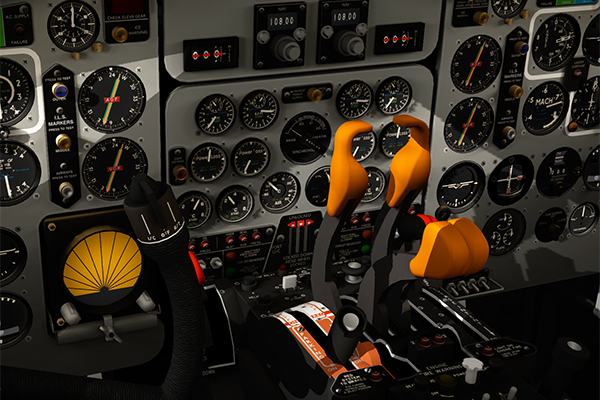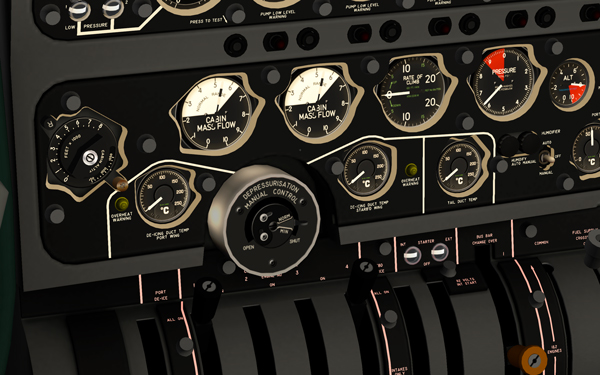Comet 4c - Descent Performance
12/08/16 13:00
Descent performance was easy to develop, because the hard work had already been done for climb performance. The principle was the same, just from top to bottom, instead of bottom to top!
Weights were not specified for descent. For the tests, I decided to use two weights at top of descent:
121,000 lb.
Maximum landing weight, plus fuel used during descent.
107,000 lb.
The normal landing weight, with full passenger complement and payload, reserve and emergency fuel still in the tanks, plus fuel used during descent.

Fig.1: Top of descent: inner throttles closed; outer engines at 6,900 RPM.
The descent procedure gave the crew quite a lot to do. There was no APU in the tail, therefore the main engines had to be kept running with sufficient power for cabin pressurisation. At the top of descent, both inner engines were reduced to idle, and the outer engines were set at specific RPM in stages:
* F. A. : Final Approach.

Fig.2: Flight Engineer's Station — Panel L — Pressurisation controls and gauges.
This would be done with the flight engineer controlling the cabin pressure, which was done manually. As with all aircraft, cabin seals worked as long as the fuselage pressure differential was positive, so care had to be taken not to let the cabin "overtake" the aircraft on the way down.

Results for high speed descent are good, until the last 5,000 feet. Attempts to correct this are at odds with climb and approach performance. I decided that, before 5,000 feet, a descent would usually be interrupted by the need to follow the correct approach pattern for an airport, or instructions from air traffic control, so accurate descent performance over the last 5,000 feet was the least important of the three.

Long range descent showed disparity between aircraft weights, but the 107,000 lb. starting weight, for a normal landing, followed the target pretty well, and I'm happy with that.
Next step: approach tests.
--
GMM-P
(12-08-2016)
Weights were not specified for descent. For the tests, I decided to use two weights at top of descent:
121,000 lb.
Maximum landing weight, plus fuel used during descent.
107,000 lb.
The normal landing weight, with full passenger complement and payload, reserve and emergency fuel still in the tanks, plus fuel used during descent.

Fig.1: Top of descent: inner throttles closed; outer engines at 6,900 RPM.
The descent procedure gave the crew quite a lot to do. There was no APU in the tail, therefore the main engines had to be kept running with sufficient power for cabin pressurisation. At the top of descent, both inner engines were reduced to idle, and the outer engines were set at specific RPM in stages:
| Altitude (ft) | Outer Engines (RPM) | Inner Engines (RPM) |
|---|---|---|
| 40,000 - 35,000 | 6,900 | Idle |
| 35,000 - 30,000 | 6,500 | Idle |
| 30,000 - 25,000 | 6,100 | Idle |
| 25,000 - 20,000 | 5,700 | Idle |
| 20,000 - 15,000 | 5,300 | Idle |
| 15,000 - 10,000 | 4,900 | Idle |
| 10,000 - F.A. | Idle | Idle |
* F. A. : Final Approach.

Fig.2: Flight Engineer's Station — Panel L — Pressurisation controls and gauges.
This would be done with the flight engineer controlling the cabin pressure, which was done manually. As with all aircraft, cabin seals worked as long as the fuselage pressure differential was positive, so care had to be taken not to let the cabin "overtake" the aircraft on the way down.

Results for high speed descent are good, until the last 5,000 feet. Attempts to correct this are at odds with climb and approach performance. I decided that, before 5,000 feet, a descent would usually be interrupted by the need to follow the correct approach pattern for an airport, or instructions from air traffic control, so accurate descent performance over the last 5,000 feet was the least important of the three.

Long range descent showed disparity between aircraft weights, but the 107,000 lb. starting weight, for a normal landing, followed the target pretty well, and I'm happy with that.
Next step: approach tests.
--
GMM-P
(12-08-2016)
blog comments powered by Disqus
